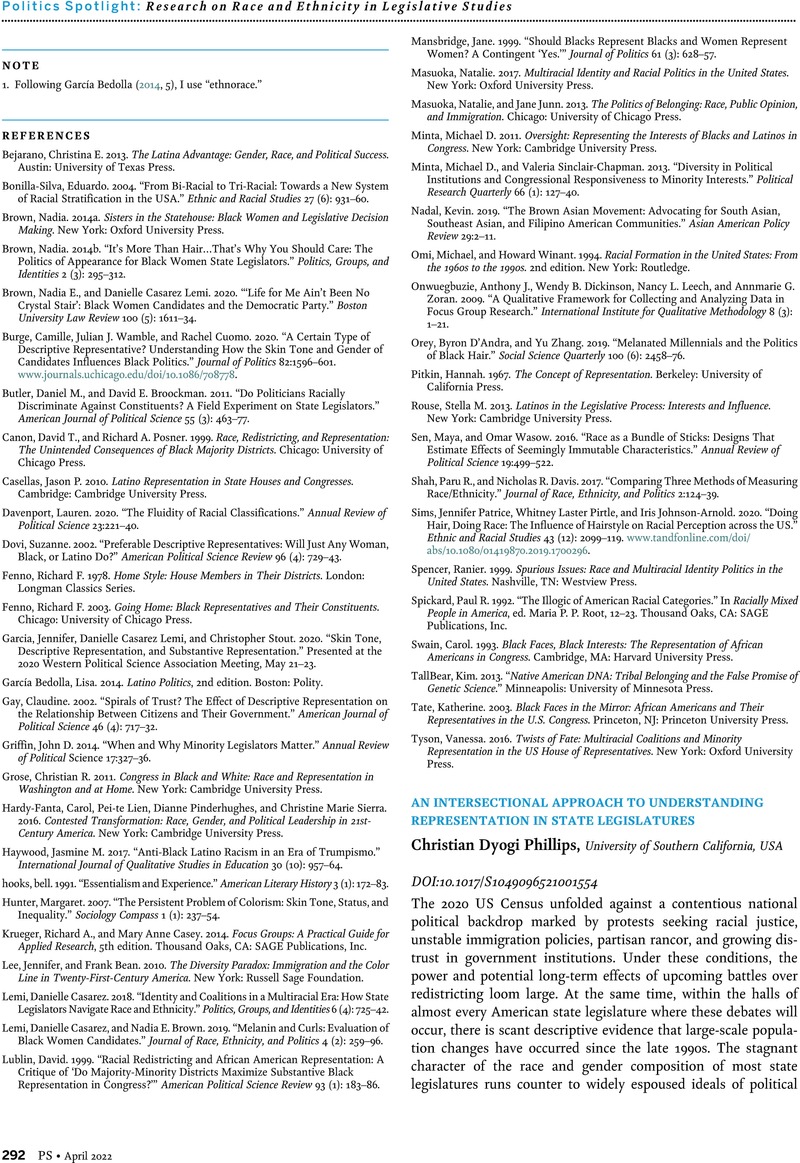No CrossRef data available.
Article contents
An Intersectional Approach to Understanding Representation in State Legislatures
Published online by Cambridge University Press: 31 March 2022
Abstract
An abstract is not available for this content so a preview has been provided. Please use the Get access link above for information on how to access this content.

- Type
- Research on Race and Ethnicity in Legislative Studies
- Information
- Copyright
- © The Author(s), 2022. Published by Cambridge University Press on behalf of the American Political Science Association
References
REFERENCES
Barreto, Matt, Segura, Gary M., and Woods, Nathan D.. 2004. “The Mobilizing Effect of Majority-Minority Districts on Latino Turnout.” American Political Science Review 98 (1): 65–75.CrossRefGoogle Scholar
Branton, Regina P. 2009. “The Importance of Race and Ethnicity in Congressional Primary Elections.” Political Research Quarterly 62 (3): 459–73.CrossRefGoogle Scholar
Brown, Nadia E. 2014. Sisters in the Statehouse: Black Women and Legislative Decision Making. New York: Oxford University Press.CrossRefGoogle Scholar
Carroll, Susan J., and Sanbonmatsu, Kira. 2013. More Women Can Run: Gender and Pathways to the State Legislatures. New York: Oxford University Press.CrossRefGoogle Scholar
Cohen, Cathy J. 1999. The Boundaries of Blackness: AIDS and the Breakdown of Black Politics. Chicago: University of Chicago Press.CrossRefGoogle Scholar
Fox, Richard L., and Lawless, Jennifer L.. 2014. “Uncovering the Origins of the Gender Gap in Political Ambition.” American Political Science Review 108 (3): 499–519.CrossRefGoogle Scholar
Hardy-Fanta, Carol, Lien, Pei-te, Pinderhughes, Dianne, and Sierra, Christine Marie. 2016. Contested Transformation: Race, Gender, and Political Leadership in 21st-Century America. Cambridge: Cambridge University Press.CrossRefGoogle Scholar
Hawkesworth, Mary. 2003. “Congressional Enactments of Race–Gender: Toward a Theory of Raced–Gendered Institutions.” American Political Science Review 97 (4): 529–50.CrossRefGoogle Scholar
Juenke, Eric Gonzalez. 2014. “Ignorance Is Bias: The Effect of Latino Losers on Models of Latino Representation.” American Journal of Political Science 58 (3): 593–603.CrossRefGoogle Scholar
Lawless, Jennifer L. 2015. “Female Candidates and Legislators.” Annual Review of Political Science 18 (1): 349–66.CrossRefGoogle Scholar
Lawless, Jennifer L., and Fox, Richard L.. 2005. It Takes a Candidate: Why Women Don’t Run for Office. Cambridge: Cambridge University Press.Google Scholar
Phillips, Christian Dyogi. 2021. Nowhere to Run: Race, Gender, and Immigration in American Elections. New York: Oxford University Press.CrossRefGoogle Scholar
Shah, Paru. 2014. “It Takes a Black Candidate: A Supply-Side Theory of Minority Representation.” Political Research Quarterly 67 (2): 266–79.CrossRefGoogle Scholar
Smooth, Wendy. 2006. “Intersectionality in Electoral Politics: A Mess Worth Making.” Politics & Gender 2 (3): 400–414.Google Scholar
Strolovitch, Dara Z. 2006. “Do Interest Groups Represent the Disadvantaged? Advocacy at the Intersections of Race, Class, and Gender.” Journal of Politics 68 (4): 894–910.CrossRefGoogle Scholar
Takash, Paule Cruz. 1993. “Breaking Barriers to Representation: Chicana/Latina Elected Officials in California.” Urban Anthropology and Studies of Cultural Systems and World Economic Development 22 (3/4): 325–60.Google Scholar




